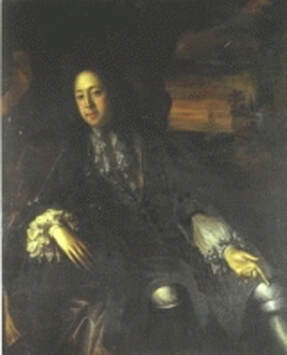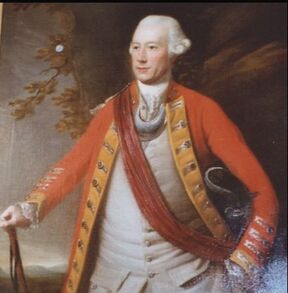Colonels of the Regiment
|
Major General Arthur Chichester, 3rd Earl of Donegall
Lord Donegall's Regiment of Foot Lord Donegall founded the regiment in 1701 in Belfast, Ireland. The Chichesters had been long established as an Anglo-Irish family. A staunch Williamite, he raised the regiment at his own expense, earning the approval of King William III. The King, of the Dutch House of Orange, gave the regiment the right to wear orange facings. He was married to Lady Catherine Forbes, whose father was Earl of Granard, a powerful Irish lord and soldier. Lord Donegall commanded Anglo-Spanish forces in the War of Spanish Succession. Lord Donegall was killed in action near Barcelona in 1706 at the age of 40. |
|
Lieutenant General Richard Gorges
Gorges' Regiment of Foot Following the death of Lord Donegall, command of the regiment passed to Richard Gorges, an Anglo-Irish officer. Gorges commanded the regiment during the war in Spain and at the catastrophic Battle of Almansa in 1707. The remnants of the regiment returned to Ireland and captured officers were eventually exchanged and repatriated. He commanded until 1717. Gorges was married to the Hon. Nicola Sophia Gorges, Lady Beresford. He died in Kilbrew, Meath, at the age of 66 on April 12, 1728. |
|
Major General Charles Otway
Otway's Regiment of Foot Hailing from Tipperary, the longest-serving colonel of the regiment, Otway commanded the regiment between 1717 and 1764. "Otway's Regiment" was given the number 35 in 1751, thereafter known as the 35th Regiment of Foot. During his tenure as colonel, the 35th Regiment served in North America and the West Indies against the French in the Seven Years War. Most notably, the 35th made a heroic but vain stand at the fall of Fort William Henry, and subsequent massacre by American Indians. The regiment, however, afterwards participated in the Battle of Quebec which ended French rule in Canada. Otway was said to have held the purse strings too tightly and the regiment was in poor condition after the Seven Years War. He married Bridget Fielding and died in Kent on August 6, 1764, aged 70. |
|
General Sir Henry Fletcher, 7th Laird of Saltoun
35th Regiment of Foot A Scotsman, Sir Henry joined the 35th Regiment as a major in 1755. He served in North America during the Seven Years War and kept a journal, which survives today. As Lieutenant Colonel, he commanded the 35th at Louisbourg and at the Battle of Quebec. He succeeded Otway as colonel on the latter's death in 1764, serving as colonel until his own death in March of 1803. Sir Henry did not serve in the American Revolution, but administered the regiment from home. In 1782, the 35th Regiment was given the county title of Dorsetshire. |
|
General Charles Lennox, 4th Duke of Richmond, KG
35th (Sussex) Regiment of Foot His Grace became colonel of the regiment in 1803 until his death in 1819. In 1805, he had the regiment renamed 35th (Sussex) Regiment, reflective of his home, as it was previously known as the 35th (Dorsetshire) Regiment. He was made Lord Lieutenant of Ireland in 1807 and was the reserve commander during the Battle of Waterloo to protect the roads to Brussels. Prior to the battle, the Duchess of Richmond held a ball for the officers of Wellington's army, the last such occasion for many who never returned. After the Napoleonic Wars, Richmond was made Governor-General of British North America. In 1819, touring Canada, he fatally contracted rabies after being bitten by a fox. |
|
General Sir John Oswald, GCB, GCMG
35th (Royal Sussex) Regiment of Foot A highly distinguished officer during the French Revolutionary Wars and Napoleonic Wars veteran, Sir John became colonel in 1819, holding that position until he died in June of 1840. According to Captain Richard Trimen, Sir John delivered the following address on the presentation of new Colours in 1834. “I feel confident, therefore, that the blue flag bestowed upon us by William the Fourth, will be followed and defended by the regiment with the same honour and credit as the orange flag given to us by William the Third; and it has always been asserted that, whether in the advance or in the retreat, in the battle or in the breach, the 35th Regiment was ever esteemed a hard- fighting corps, ready and able to perform its duty as a trustworthy regiment.” |





